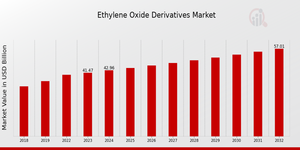Ethylene Oxide Derivatives Industry: Key Players and Market Insights
Body
Introduction
The global chemical industry is a dynamic and ever-evolving landscape, with ethylene oxide derivatives playing a pivotal role in shaping various sectors. Ethylene oxide (EO) is a versatile chemical compound that serves as a building block for a wide range of derivatives, which are essential in industries such as healthcare, automotive, textiles, and personal care. As the demand for these derivatives continues to grow, the Ethylene Oxide Derivatives Market is poised for significant expansion. In this blog, we’ll explore the latest trends, applications, and future prospects of this burgeoning market.
What Are Ethylene Oxide Derivatives?
Ethylene oxide derivatives are chemical compounds derived from ethylene oxide through various chemical reactions. Some of the most common derivatives include:
- Ethylene Glycols: Used in antifreeze, polyester fibers, and polyethylene terephthalate (PET) plastics.
- Ethoxylates: Key ingredients in detergents, emulsifiers, and surfactants.
- Ethanolamines: Utilized in gas treatment, personal care products, and agrochemicals.
- Glycol Ethers: Found in paints, coatings, and cleaning products.
- Polyethylene Glycols (PEGs): Widely used in pharmaceuticals, cosmetics, and industrial applications.
These derivatives are valued for their unique properties, such as solubility, reactivity, and versatility, making them indispensable in numerous industrial processes.
Market Trends Driving Growth
- Increasing Demand for Personal Care and Cosmetics: The personal care industry is experiencing robust growth, driven by rising consumer awareness and demand for high-quality products. Ethylene oxide derivatives, particularly ethoxylates and PEGs, are widely used in shampoos, lotions, and other cosmetic formulations due to their emulsifying and moisturizing properties.
- Expansion of the Pharmaceutical Industry: The pharmaceutical sector is another major consumer of ethylene oxide derivatives. PEGs, for instance, are used as excipients in drug formulations, while ethanolamines are employed in the production of active pharmaceutical ingredients (APIs). The ongoing development of new drugs and biologics is expected to further boost demand.
- Growth in the Automotive Sector: Ethylene glycol, a key derivative, is a critical component in automotive antifreeze and coolant solutions. With the global automotive industry expanding, particularly in emerging markets, the demand for ethylene glycol is set to rise.
- Sustainability and Green Chemistry: As environmental concerns gain traction, there is a growing emphasis on sustainable and eco-friendly chemical processes. Manufacturers are increasingly adopting green chemistry principles to produce ethylene oxide derivatives with lower environmental impact, such as bio-based ethoxylates and glycols.
- Technological Advancements: Innovations in production technologies are enhancing the efficiency and cost-effectiveness of ethylene oxide derivative manufacturing. Advanced catalysts, process optimization, and automation are enabling manufacturers to meet the rising demand while maintaining high-quality standards.
Applications Across Industries
The versatility of ethylene oxide derivatives is evident in their wide-ranging applications across various industries:
- Healthcare: Ethylene oxide derivatives are used in the production of medical devices, sterilization processes, and pharmaceutical formulations.
- Textiles: Ethoxylates and glycol ethers are essential in textile processing, including dyeing, finishing, and fabric softening.
- Agriculture: Ethanolamines are used in the formulation of herbicides, pesticides, and fertilizers.
- Construction: Glycol ethers are key components in paints, coatings, and adhesives used in the construction industry.
- Food and Beverage: PEGs are used as food additives and in packaging materials.
Challenges and Opportunities
While the ethylene oxide derivatives market is on an upward trajectory, it is not without challenges. Regulatory scrutiny, particularly concerning the environmental and health impacts of ethylene oxide, poses a significant hurdle. Stricter regulations on emissions and waste disposal are compelling manufacturers to invest in cleaner and safer production methods.
However, these challenges also present opportunities for innovation. Companies that can develop sustainable and eco-friendly derivatives are likely to gain a competitive edge. Additionally, the growing demand for bio-based and renewable chemicals opens new avenues for market players to explore.
Future Prospects
The future of the ethylene oxide derivatives market looks promising, with several factors contributing to its growth:
- Emerging Markets: Rapid industrialization and urbanization in emerging economies, particularly in Asia-Pacific and Latin America, are driving demand for ethylene oxide derivatives. Countries like China, India, and Brazil are expected to be key growth markets.
- Innovation in Product Development: Ongoing research and development efforts are likely to yield new and improved derivatives with enhanced properties and applications. This will further expand the market’s potential.
- Strategic Collaborations: Partnerships and collaborations between chemical manufacturers, research institutions, and end-user industries are fostering innovation and accelerating market growth.
- Focus on Sustainability: As sustainability becomes a top priority, the development of green and bio-based ethylene oxide derivatives will gain momentum, offering new growth opportunities.










Comments